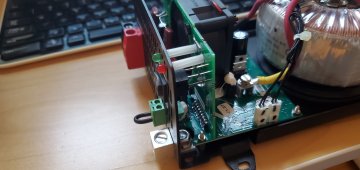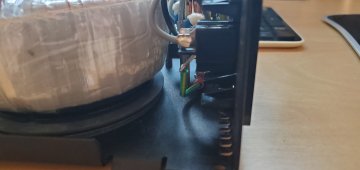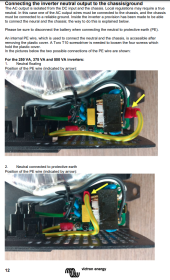I have a small popup camper in which I installed a small inverter to power the outlets from the battery when not connected to shore power or generator. It's really just to conveniently plug in low draw appliances in a conveniently located pre-existing outlets as opposed to using an extension cords or dedicated outlet(s) for the inverter. It is wired as follows:

The "Branch Circuit Breaker" is part of the RV's power center, a WF-8725 by WFCO. There is no EMS on this RV. The power center powers 4 outlets when connected to shore power so all I did was add a transfer switch between the first outlet of the circuit and the power center. When the RV is connected to shore power or a generator, the transfer switch powers the outlets from shore power/generator and when the RV is disconnected, it powers the outlets from the inverter. In order to avoid a charging loop, I ran new wiring directly from the battery to the inverter, bypassing the power center so as to not create a charge-discharge loop through the RV converter/battery charger. When off-grid, the battery powers the power center, which powers the 12V circuits of the RV and the battery powers the inverter which powers the AC outlets of the RV.
The AC Loads in the diagram consist of 4 GFCI outlets that were pre-installed in the RV. The Inverter is a Victron Phoenix 12/375VA, which has a floating neutral with the option to bond ground and neutral.
My first question is: should I Ground-Neutral bond the inverter? Would creating a return path to the inverter in case of a fault be more dangerous since it doesn't have an AC breaker or are the fuses on the DC side enough to protect me?
My second questions is: In either case, should I connect the inverter's ground screw to the chassis?
EDIT: If I ground-neutral bond the inverter, then it's already grounded to the chassis through the battery negative so it would be grounded twice. If I do not ground-neutral bond the inverter, then the ground screw would ground the frame of the inverter to the chassis but would not protect against a fault. Am I right?
My third question is: with shore power, the gound-neutral bond happens in the panel from which the power originates but my generator, a Honda EU2200i, has a floating neutral. Should I use a ground-neutral bond plug on the generator as well to allow the generator's breaker to trip in case of a fault?
These sound like obvious questions but I've been reading about this a lot and, while I've learned a great deal, I'm also more confused than when I started.
Thank you in advance for reading this long post. Your advice and the time you take to reply is sincerely appreciated!

The "Branch Circuit Breaker" is part of the RV's power center, a WF-8725 by WFCO. There is no EMS on this RV. The power center powers 4 outlets when connected to shore power so all I did was add a transfer switch between the first outlet of the circuit and the power center. When the RV is connected to shore power or a generator, the transfer switch powers the outlets from shore power/generator and when the RV is disconnected, it powers the outlets from the inverter. In order to avoid a charging loop, I ran new wiring directly from the battery to the inverter, bypassing the power center so as to not create a charge-discharge loop through the RV converter/battery charger. When off-grid, the battery powers the power center, which powers the 12V circuits of the RV and the battery powers the inverter which powers the AC outlets of the RV.
The AC Loads in the diagram consist of 4 GFCI outlets that were pre-installed in the RV. The Inverter is a Victron Phoenix 12/375VA, which has a floating neutral with the option to bond ground and neutral.
My first question is: should I Ground-Neutral bond the inverter? Would creating a return path to the inverter in case of a fault be more dangerous since it doesn't have an AC breaker or are the fuses on the DC side enough to protect me?
My second questions is: In either case, should I connect the inverter's ground screw to the chassis?
EDIT: If I ground-neutral bond the inverter, then it's already grounded to the chassis through the battery negative so it would be grounded twice. If I do not ground-neutral bond the inverter, then the ground screw would ground the frame of the inverter to the chassis but would not protect against a fault. Am I right?
My third question is: with shore power, the gound-neutral bond happens in the panel from which the power originates but my generator, a Honda EU2200i, has a floating neutral. Should I use a ground-neutral bond plug on the generator as well to allow the generator's breaker to trip in case of a fault?
These sound like obvious questions but I've been reading about this a lot and, while I've learned a great deal, I'm also more confused than when I started.
Thank you in advance for reading this long post. Your advice and the time you take to reply is sincerely appreciated!
Last edited:





